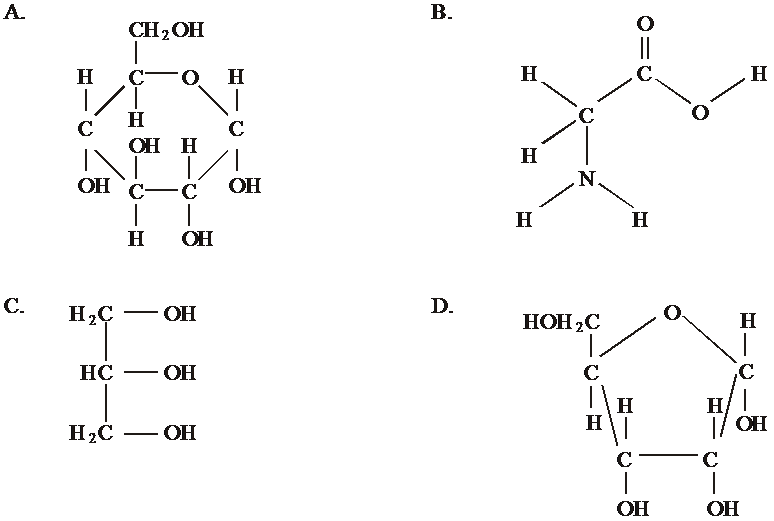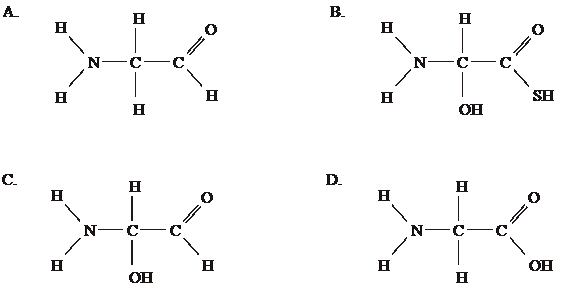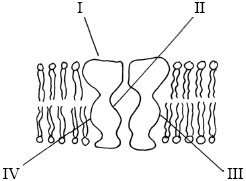Super Fun Biochemistry Exam!
.jpg)
Are you a biochemistry student who is struggling to understand the subject? Why not give this super fun biochemistry exam a try? You can strengthen your fundamentals of biochemistry by playing this quiz. Interestingly, it can also be crucial in your examination preparations. All the questions asked are designed to test your knowledge and make you think outside the box! Now, that's interesting, isn't it? Please make sure to read all the questions carefully before attempting. We wish you all the very best!
- 1.
Which molecule represents ribose?
- A.
A
- B.
B
- C.
C
- D.
D
Correct Answer
D. DExplanation
Ribose is a type of sugar molecule that is found in RNA (ribonucleic acid). It is a pentose sugar, meaning it has five carbon atoms. Among the given options, molecule D represents ribose as it has five carbon atoms and the correct chemical structure for ribose.Rate this question:
-
- 2.
Which of the following reactions occurs when a dipeptide is formed from amino acids?
- A.
Hydrolysis
- B.
Denaturation
- C.
Condensation
- D.
Oxidation
Correct Answer
C. CondensationExplanation
When a dipeptide is formed from amino acids, the reaction that occurs is condensation. Condensation is a chemical reaction in which two molecules combine to form a larger molecule, with the simultaneous release of a small molecule such as water. In the case of dipeptide formation, two amino acids combine, and a water molecule is released as a byproduct. This reaction is also known as dehydration synthesis. Hydrolysis, denaturation, and oxidation are not the correct answers because they do not describe the specific reaction involved in dipeptide formation.Rate this question:
-
- 3.
Which is not a primary function of protein molecules?
- A.
Hormones
- B.
Energy store
- C.
Transport
- D.
Structure
Correct Answer
B. Energy storeExplanation
Protein molecules have various functions in the body, including acting as enzymes, hormones, and transporters, as well as providing structural support. However, storing energy is not a primary function of protein molecules. Carbohydrates and fats are the main sources of energy storage in the body, while proteins are primarily involved in building and repairing tissues, regulating metabolism, and supporting various physiological processes.Rate this question:
-
- 4.
Which structure represents an amino acid?
- A.
A
- B.
B
- C.
C
- D.
D
Correct Answer
D. DExplanation
Structure D represents an amino acid because it consists of an amino group (NH2), a carboxyl group (COOH), and a side chain (R group) attached to a central carbon atom. This structure is characteristic of amino acids, which are the building blocks of proteins. Structures A, B, and C do not have the necessary components to represent an amino acid.Rate this question:
-
- 5.
The diagram below shows a channel protein in a membrane. Which parts of the surface of the protein would be composed of polar amino acids.
- A.
I and II only
- B.
II and III only
- C.
III and IV only
- D.
I and IV only
Correct Answer
A. I and II onlyExplanation
The diagram shows a channel protein in a membrane. Polar amino acids are hydrophilic and are attracted to water. In the diagram, regions I and II are exposed to the aqueous environment on either side of the membrane. These regions are likely to be composed of polar amino acids to interact with the water molecules. Regions III and IV, on the other hand, are embedded within the hydrophobic lipid bilayer of the membrane and are less likely to contain polar amino acids. Therefore, the correct answer is I and II only.Rate this question:
-
- 6.
What is the advantage of using pectinase in fruit juice production?
- A.
The pectin content of the fruit is increased, making the nutritional value of the juice higher.
- B.
The pectin content of the fruit is reduced, making the energy content of the juice lower.
- C.
The pectin content of the fruit is reduced, making the juice easier to extract.
- D.
The pectin content of the fruit is increased, giving the juice a thicker texture.
Correct Answer
C. The pectin content of the fruit is reduced, making the juice easier to extract.Explanation
Pectinase is an enzyme that breaks down pectin, a substance found in the cell walls of fruits. By using pectinase in fruit juice production, the pectin content of the fruit is reduced. This reduction in pectin makes the juice easier to extract because pectin can cause the juice to become thick and gel-like. Therefore, using pectinase helps to improve the efficiency of juice extraction, resulting in a smoother and more fluid juice product.Rate this question:
-
- 7.
Which of the following could cause denaturation of an enzyme?
- A.
Substrate concentration
- B.
A competitive inhibitor
- C.
High temperature
- D.
Low salt concentration
Correct Answer
C. High temperatureExplanation
High temperature can cause denaturation of an enzyme. Enzymes have specific three-dimensional structures that are essential for their function. When exposed to high temperatures, the increased kinetic energy causes the enzyme's structure to unravel or unfold, disrupting the active site and rendering the enzyme inactive. This loss of structure is known as denaturation, and it prevents the enzyme from catalyzing reactions effectively.Rate this question:
-
- 8.
What is the composition of the backbone of DNA?
- A.
Alternating sugar and phosphate molecules
- B.
Complementary base pairs
- C.
Alternating sugar and base molecules
- D.
A polysaccharide
Correct Answer
A. Alternating sugar and phosphate moleculesExplanation
The backbone of DNA is composed of alternating sugar and phosphate molecules. These molecules are connected by covalent bonds, forming a stable and strong structure. The sugar molecules in the backbone are deoxyribose, and the phosphate molecules are attached to the 5' carbon of one sugar and the 3' carbon of the adjacent sugar. This alternating sugar-phosphate backbone provides stability to the DNA molecule and serves as a platform for the attachment of nucleotide bases, which form the complementary base pairs.Rate this question:
-
- 9.
Which of the following are connected by a hydrogen bond?
- A.
The hydrogen and oxygen atoms of a water molecule
- B.
A base pair of a DNA molecule
- C.
Two amino acid molecules of a dipeptide
- D.
Two glucose molecules in a disaccharide
Correct Answer
B. A base pair of a DNA moleculeExplanation
A base pair of a DNA molecule is connected by a hydrogen bond. In DNA, the bases adenine (A) and thymine (T) are connected by two hydrogen bonds, while the bases guanine (G) and cytosine (C) are connected by three hydrogen bonds. These hydrogen bonds play a crucial role in maintaining the double helix structure of DNA and ensuring the accurate replication and transmission of genetic information.Rate this question:
-
- 10.
What is the function of helicase?
- A.
It forms bonds between DNA nucleotides.
- B.
It adds new nucleotides to the DNA helix.
- C.
It forms the DNA helix.
- D.
It separates DNA strands.
Correct Answer
D. It separates DNA strands.Explanation
Helicase is an enzyme responsible for separating the DNA strands during DNA replication. It does this by breaking the hydrogen bonds between the complementary base pairs, allowing the two strands to unwind and separate. This process is essential for DNA replication and other DNA-related processes like transcription and repair. Therefore, the function of helicase is to separate DNA strands.Rate this question:
-
- 11.
The diagram below shows a short section of the DNA molecules before and after replication. If the nucleotides used to replicate the DNA were radioactive, which strands in the replicated molecules would be radioactive?
- A.
II and III only
- B.
I and III only
- C.
I and II only
- D.
I, II, III and IV
Correct Answer
A. II and III onlyExplanation
During DNA replication, the two strands of the original DNA molecule separate and serve as templates for the synthesis of two new complementary strands. In the diagram, the original DNA molecule is represented by strand I and strand II. After replication, the new strands are formed: strand I' and strand II'. Since the nucleotides used for replication were radioactive, only the newly synthesized strands (strand I' and strand II') would be radioactive. Therefore, the correct answer is II and III only.Rate this question:
-
- 12.
What is removed to form mature eukaryotic mRNA?
- A.
RNA primers
- B.
Exons
- C.
RNA polymerases
- D.
Introns
Correct Answer
D. IntronsExplanation
Introns are removed to form mature eukaryotic mRNA. Introns are non-coding regions of DNA that are transcribed into RNA but are not translated into proteins. They are initially present in the pre-mRNA molecule and need to be removed through a process called splicing. This process involves the removal of introns and joining together of the remaining coding regions called exons. The resulting mRNA molecule contains only the exons and is ready to be translated into a protein.Rate this question:
-
- 13.
A certain gene codes for a polypeptide that is 120 amino acids long. Approximately how many nucleotides long is the mRNA that codes for this polypeptide likely to be?
- A.
30
- B.
40
- C.
360
- D.
480
Correct Answer
C. 360Explanation
The mRNA that codes for a polypeptide is typically longer than the polypeptide itself because each amino acid is coded by a sequence of three nucleotides called a codon. Since the polypeptide is 120 amino acids long, the mRNA is likely to be 120 x 3 = 360 nucleotides long.Rate this question:
-
- 14.
Where do transcription and translation occur in eukaryotic cells?
- A.
Both in the cytoplasm
- B.
Transcription in the cytoplasm, translation in the nucleus
- C.
Transcription in the nucleus, translation in the cytoplasm
- D.
Both in the nucleus
Correct Answer
C. Transcription in the nucleus, translation in the cytoplasmExplanation
Transcription is the process of synthesizing mRNA from DNA, and it occurs in the nucleus of eukaryotic cells. Translation is the process of protein synthesis, where the mRNA is used as a template to assemble amino acids into a protein. Translation occurs in the cytoplasm, specifically on ribosomes. Therefore, the correct answer is that transcription occurs in the nucleus, while translation occurs in the cytoplasm.Rate this question:
-
- 15.
Of the following products, which is produced by both anaerobic respiration and aerobic respiration in humans? I - Pyruvate II - ATP III - Lactate
- A.
I only
- B.
I and II only
- C.
I, II and III
- D.
II and III only
Correct Answer
B. I and II onlyExplanation
Both pyruvate and ATP are produced by both anaerobic respiration and aerobic respiration in humans. Pyruvate is a product of glycolysis, which occurs during both anaerobic and aerobic respiration. ATP is the main energy currency of the cell and is produced through the electron transport chain in aerobic respiration and through substrate-level phosphorylation in anaerobic respiration. Lactate, on the other hand, is produced only during anaerobic respiration as a byproduct of the conversion of pyruvate.Rate this question:
-
- 16.
What is needed in photosynthesis to convert carbon dioxide into organic molecules?
- A.
Light and hydrogen from the splitting of water
- B.
Light and oxygen from the splitting of water
- C.
ATP and hydrogen from the splitting of water
- D.
ATP and oxygen from the splitting of water
Correct Answer
C. ATP and hydrogen from the splitting of waterExplanation
During photosynthesis, carbon dioxide is converted into organic molecules. This process requires ATP, which is a form of energy, and hydrogen from the splitting of water. Light is also needed in photosynthesis, but it is not directly involved in the conversion of carbon dioxide into organic molecules. Oxygen is produced as a byproduct of photosynthesis, but it is not required for the conversion of carbon dioxide.Rate this question:
-
- 17.
Pigments are extracted from the leaves of a green plant. White light is then passed through the solution of pigments. What effect do the leaf pigments have on the white light?
- A.
Green wavelengths are absorbed and red and blue wavelengths are transmitted.
- B.
Red and blue wavelengths are absorbed and green wavelengths are transmitted.
- C.
Blue wavelengths are absorbed and green and red wavelengths are transmitted.
- D.
Green and red wavelengths are absorbed and blue wavelengths are transmitted.
Correct Answer
B. Red and blue wavelengths are absorbed and green wavelengths are transmitted.Explanation
The correct answer is "Red and blue wavelengths are absorbed and green wavelengths are transmitted." This is because pigments in the leaves of a green plant absorb certain wavelengths of light while allowing others to be transmitted. In this case, the pigments in the leaves absorb red and blue wavelengths of light, while green wavelengths are transmitted. This is why we perceive the leaves as green.Rate this question:
-
- 18.
One of the roles of nitrogen in living things is:
- A.
In the production of amino acids
- B.
In the production of carbohydrates
- C.
In the production of lipids
- D.
In all of the above
Correct Answer
A. In the production of amino acidsExplanation
Nitrogen plays a crucial role in the production of amino acids, which are the building blocks of proteins. Amino acids are essential for various biological processes, including the synthesis of enzymes, hormones, and antibodies. Nitrogen is a key component of the amino acid structure, as it is required to form the amine group (-NH2) present in all amino acids. Therefore, the correct answer is that nitrogen is involved in the production of amino acids.Rate this question:
-
- 19.
Water molecules are described as being dipolar. This means that
- A.
It has one oxygen atom and two hydrogen atoms
- B.
It has one hydrogen atom and two oxygen atoms
- C.
It has negative and positive "ends"
- D.
It has two negative "ends"
Correct Answer
C. It has negative and positive "ends"Explanation
Water molecules are described as being dipolar because they have a partial negative charge on the oxygen atom and a partial positive charge on the hydrogen atoms. This is due to the unequal sharing of electrons between the oxygen and hydrogen atoms in the molecule. The oxygen atom attracts the shared electrons more strongly, creating a negative charge near the oxygen atom and a positive charge near the hydrogen atoms. This polarity allows water molecules to form hydrogen bonds with each other and other polar molecules, giving water its unique properties such as high boiling point and surface tension.Rate this question:
-
- 20.
The sugar lactose is composed of?
- A.
Two glucose molecules
- B.
One glucose and one sucrose molecule
- C.
One glucose and one galactose molecule
- D.
One galactose and one sucrose molecule
Correct Answer
C. One glucose and one galactose moleculeExplanation
Lactose is a disaccharide sugar composed of one glucose molecule and one galactose molecule. This means that lactose is formed by the condensation reaction between a glucose molecule and a galactose molecule, resulting in the formation of a glycosidic bond.Rate this question:
-
Quiz Review Timeline +
Our quizzes are rigorously reviewed, monitored and continuously updated by our expert board to maintain accuracy, relevance, and timeliness.
-
Current Version
-
Aug 26, 2023Quiz Edited by
ProProfs Editorial Team -
Feb 03, 2010Quiz Created by
Kris_french
- Aeronautics Quizzes
- Aerospace Quizzes
- Agricultural Science Quizzes
- Astrology Quizzes
- Astronomy Quizzes
- Atom Quizzes
- Biology Quizzes
- Biomechanics Quizzes
- Biostatistics Quizzes
- Biotechnology Quizzes
- Botany Quizzes
- Branches Of Science Quizzes
- Cytology Quizzes
- Easy Science Quizzes
- Ecology Quizzes
- Electrical Quizzes
- Embryology Quizzes
- Endocrinology Quizzes
- Engineering Quizzes
- Environmental Science Quizzes
- Epidemiology Quizzes
- Experiment Quizzes
- Forestry Quizzes
- Fossil Quizzes
- Gas Quizzes
- General Science Quizzes
- Genetics Quizzes
- Histology Quizzes
- Human Biology Quizzes
- Integrated Science Quizzes
- Invention Quizzes
- Library Science Quizzes
- Lighting Quizzes
- Liquid Quizzes
- Marine Biology Quizzes
- Microbiology Quizzes
- Nature Quizzes
- Neuroscience Quizzes
- Nuclear Science Quizzes
- Oceanography Quizzes
- Physics Quizzes
- Psychology Quizzes
- Science And Technology Quizzes
- Science Glossary Quizzes
- Science Knowledge Quizzes
- Science Practice Quizzes
- Scientific Method Quizzes
- Scientific Notation Quizzes
- Soil Science Quizzes
- Solar System Quizzes
- Solid Quizzes
- Zoology Quizzes
 Back to top
Back to top






